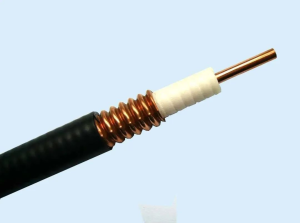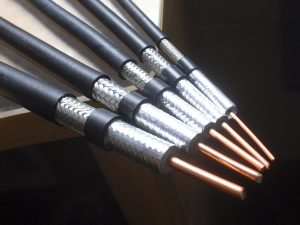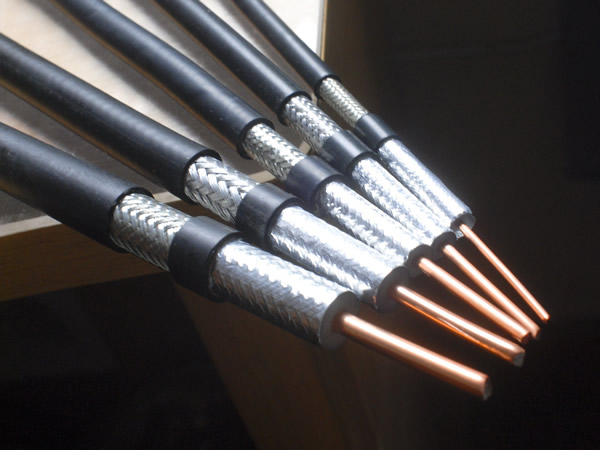A coaxial cable is a wire and signal transmission line, generally caused by four layers of material.
The innermost is a conductive copper wire, and the outside of the line has a layer of plastic surrounding it, it is an insulator and dielectric use.
Insulator outside and a thin layer of mesh conductive body, generally copper or alloy.
Then the conductive body outside is the outermost layer of insulating material as the outer skin.
What is coaxial cable used for?
Coaxial cables can be used for the transmission of analog and digital signals for a wide variety of applications, the most important of which is cable television transmission. Long-distance telephone transmission, short-distance connections between computer systems, and local area networks.
Cable wire coaxial is developing rapidly as a means of distributing television signals to thousands of homes, which is cable television. A cable TV system can be loaded with dozens or even hundreds of TV channels, and its transmission range can reach tens of kilometers.

Coaxial cables are generally divided into the following two categories, depending on their structural role:
Baseband coaxial cable
The shield of baseband coaxial cable wire is usually a mesh structure made of copper with a characteristic impedance of 50 Ω.
This cable is used to transmit digital signals and is generally available in RG-8 thick cable and RG-58 thin cable.
The most intuitive difference between coarse and fine cables is the difference in cable diameter.
The coaxial cord is suitable for larger local networks, it has a long standard distance and high reliability.
However, coarse cable networks must be installed with transceiver and transceiver cable, the installation is also difficult. So the overall cost is high. In contrast, the thin cable is simpler and less expensive.
However, because the cable has to be cut off during installation, it is prone to the potential for poor contact when there are many connectors.
Whether the network is connected using thick or thin cables, the point of failure often affects all machines on the entire cable. And the fault is troublesome to diagnose and repair.
Therefore, baseband coaxial cables have been gradually replaced by shielded twisted pairs or fiber optic cables.
Broadband Coaxial Cable
Wideband coaxial cable has a shield usually stamped from aluminum and has a characteristic impedance of 75 Ω.
This cable is usually used to transmit analog signals, commonly known as RG-59, and is the standard transmission cable used in cable television networks, allowing multiple television signals to be transmitted simultaneously in a single cable.
Broadband coaxial cable can also be used as a transmission medium for some computer networks.
Coaxial cables have always been an important part of long-distance telephone networks.
However, in today’s rapidly developing society, it faces increasing competition from optical fiber, terrestrial microwave, and satellite.
The main differences between the three are as follows:
Twisted pair cable
- It has many advantages such as strong anti-interference ability, long transmission distance, easy wiring, and low price.
- Because the twisted-pair cable also has a large attenuation of the signal, the transmission distance is. Any of the signal frequencies can not be too high, while high-speed signals such as Ethernet can only be limited to 100 m.
- For video signals, bandwidth up to 6MHz, if directly within the twisted pair transmission, will also be attenuated greatly.
So the video signal in the twisted pair to achieve long-distance transmission must be amplified and compensated, twisted pair video transmission equipment is to complete this function.
- Twisted pair and twisted pair video transmission equipment are very cheap, not only did not increase the cost of the system, but also the distance increased when its cost compared with coaxial cable decreased a lot.
- Therefore, the monitoring system with twisted pair for transmission has obvious advantages.
Optical fiber Cable
- Optical fiber transmits signals in the form of light pulses, so the material is also mainly glass or plexiglass. It consists of a fiber core, cladding and protective jacket.
2. The structure of the optical fiber is very similar to that of coaxial cable, with the center being an optical fiber made of glass or transparent plastic, surrounded by a protective material, and multiple fibers can be combined inside a single fiber optic cable as needed.
- The most important feature of optical fiber is that it conducts optical signals, so it is not subject to interference from external electromagnetic signals, and the signal attenuation rate is very slow.
Therefore, the signal transmission distance is much farther than the above transmission of electrical signals of various network cables and is particularly suitable for the electromagnetic environment in harsh places.
- Due to the optical reflection characteristics of optical fiber, an optical fiber can transmit multiple signals at the same time, so the transmission speed of optical fiber can be very high, theoretically the highest fiber optic network can reach 50,000Gbps 50Tbps speed.
- The use of optical fiber as a network transmission medium requires a certain level of expertise and specialized equipment such as optical transceivers, so the cost investment is greater and is less used in general applications.

Coaxial Cable
- A cable coaxial is a cable line consisting of layers of insulated wires wrapped around a central copper conductor.
It is characterized by good anti-interference ability, the stable transmission of data, and cheap price, and is also widely used, such as closed-circuit TV lines.
- A coaxial thin cable line is generally sold in the market for a few dollars a meter, not too expensive.
The coaxial cable is used to connect with the BNC head. The coaxial cable provided by the ZMS cable supplier is generally a finished product that has been connected to the BNC head, so you can choose it directly.
- According to the analysis of the coaxial cable’s characteristics, when the signal is transmitted in the coaxial cable, the attenuation is related to the transmission distance and the frequency of the signal itself.
Generally speaking, the higher the frequency of the signal, the greater the attenuation.
- The bandwidth of the video signal is very large, up to 6MHz, and the color part of the image is modulated at the high end of the frequency. In this way, the video signal in the coaxial cable transmission not only the overall amplitude of the signal by the attenuation, and the frequency components of the attenuation are very different, especially the color part of the attenuation is the largest.
- Coaxial cable is only suitable for close-distance transmission of image signals. When the transmission distance reaches about 200 meters, the image quality will be significantly reduced, especially the color becomes dark and distorted.
- The coaxial amplifier has certain amplification of video signal and also can compensate different sizes of different frequency components respectively through equalization adjustment so that the output video signal distortion at the receiving end is as small as possible.
- When using coaxial cable in the monitoring system, the transmission distance is generally limited to about four or five hundred meters to ensure better image quality.
The above is an introduction to coaxial cable, the cable often used in life, if you have any doubts about the purchase, we have a professional cable sales representative with one-stop service to help you.
